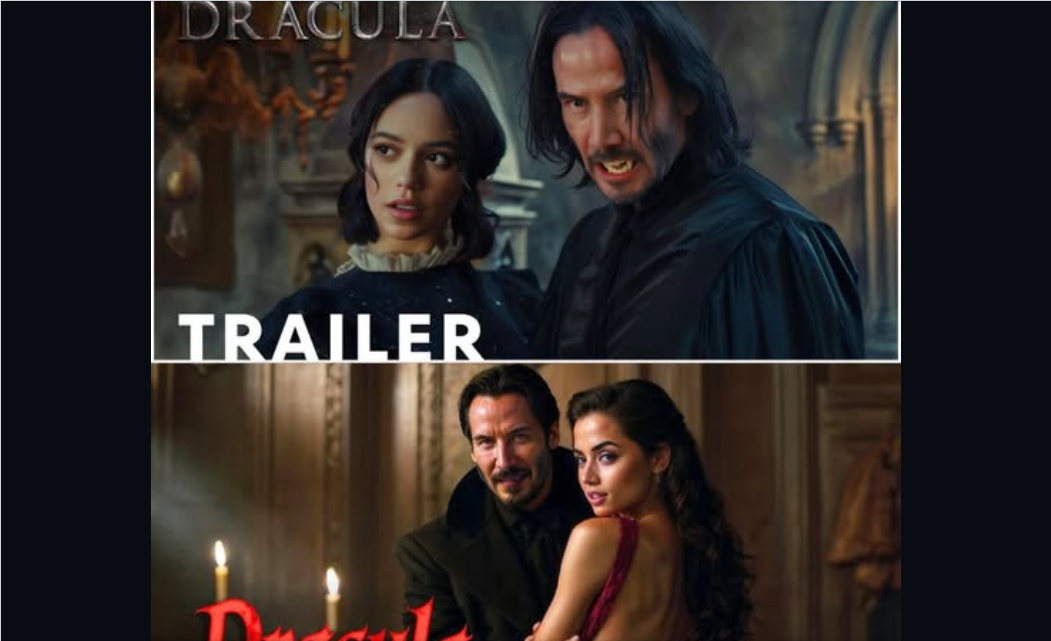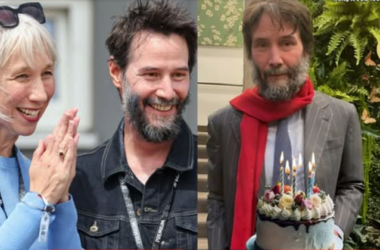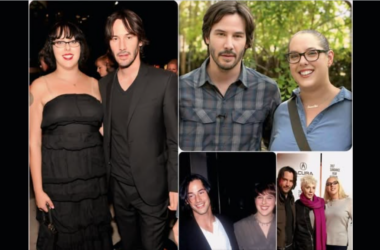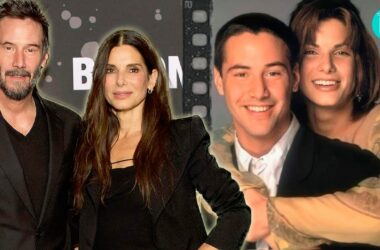
Reviving the Eternal Night with a Romantic Twist
In the ever-evolving landscape of cinematic horror and romance, few figures loom as large as Count Dracula, the iconic vampire created by Bram Stoker in 1897. Over the decades, Dracula has been reimagined countless times—from Bela Lugosi’s chilling portrayal in the 1931 classic to Gary Oldman’s brooding intensity in Francis Ford Coppola’s 1992 adaptation. Now, in 2025, director Sofia Coppola brings us Dracula: The Love Tale, a film that daringly transforms the blood-soaked horror of the original into an operatic romance that whispers of eternal love and inevitable doom. Starring Lily James as the dream-haunted heroine, Timothée Chalamet as the tormented Dracula, Tilda Swinton as a wise elder vampire, and Keanu Reeves as a vengeful human hunter, this film is a poetic exploration of memory, loss, and the seductive pull of the undead.
Released on July 25, 2025, Dracula: The Love Tale has already captivated audiences with its lush visuals, magnetic performances, and a narrative that prioritizes emotional depth over gore. Clocking in at 8.5 out of 10, the film stands out for its innovative blend of genres, turning the vampire myth into a tragic love story that seduces the soul rather than merely terrifying it. This review delves into the film’s highlights, analyzing its standout elements—from the ethereal chemistry between James and Chalamet to the haunting cinematography that bathes every scene in candlelight and snowfall. What makes this adaptation so compelling is its ability to humanize the monster, making Dracula not a predator of the night, but a lover cursed by time.
The Plot: Whispers from Centuries Past
At its core, Dracula: The Love Tale reimagines the vampire legend through the lens of memory and reincarnation. Unlike traditional adaptations where Dracula emerges from a dusty coffin in Transylvania, here he awakens not from slumber but from the recesses of forgotten memories. The story centers on Mina (Lily James), a modern-day woman plagued by vivid dreams that echo whispers from centuries ago. These dreams draw her into a web of fate, leading her to Jonathan (Timothée Chalamet), a enigmatic young man who seems both familiar and dangerously alluring. Unbeknownst to Mina, Jonathan is the reincarnation of Dracula, doomed to relive a cycle of love that always ends in tragedy—remembering affection only as it fades into oblivion.
Guarding this tragic lore is Van Helsing’s counterpart, an elder vampire played by Tilda Swinton, who serves as a custodian of vampire history, warning of the perils of human-vampire entanglements. Enter Abraham (Keanu Reeves), a weathered human hunter driven by personal vengeance, whose pursuit adds layers of tension and moral complexity. The narrative unfolds like an opera, with acts of passion interspersed with moments of quiet introspection. Blood spills not in torrents but slowly, like wine poured for the damned, symbolizing the intoxicating yet fatal nature of their romance. Each kiss feels like a binding contract, each step toward love a descent into inevitable oblivion.
What elevates the plot is its departure from Stoker’s horror roots. Coppola, known for her atmospheric films like The Virgin Suicides and Marie Antoinette, infuses the story with a gothic poetry that prioritizes emotional resonance. The film explores themes of eternal love versus mortal fragility, questioning whether true affection can transcend the curse of immortality. Without spoiling key twists, the storyline builds to a crescendo that leaves viewers pondering the cost of undying passion, making it a standout in the crowded field of vampire tales.
Stellar Performances: Magnetism and Depth
The film’s success hinges on its exceptional cast, each delivering performances that are as haunting as they are heartfelt. Lily James, fresh from her roles in Cinderella and Rebecca, embodies Mina with an ethereal vulnerability. Her portrayal captures the character’s internal turmoil—dreams that blur the line between reality and fantasy. James’s expressive eyes convey a depth of longing and fear, making Mina not just a victim but a proactive force in the narrative. Her chemistry with Chalamet is electric, a star-crossed attraction that feels both predestined and perilous. In scenes where Mina confronts her visions, James’s subtle shifts from curiosity to terror are masterful, drawing audiences into her psyche.
Timothée Chalamet, the young Oscar nominee known for Dune and Call Me by Your Name, takes on Dracula (disguised as Jonathan) with a tortured elegance that redefines the character. Gone is the cape-twirling villain; in his place is a young man burdened by centuries of loss. Chalamet’s performance is magnetic—his boyish charm masks a profound sadness, evident in quiet moments where he gazes at Mina with a mixture of hope and despair. His physicality, graceful yet restrained, evokes the vampire’s ancient poise, while his emotional delivery in monologues about forgotten loves tugs at the heartstrings. The duality of innocence and doom in Chalamet’s portrayal is one of the film’s greatest strengths, making Dracula a tragic figure worthy of sympathy.
Tilda Swinton, an icon of otherworldly roles in films like We Need to Talk About Kevin and Suspiria, commands the screen as the elder vampire, Elowen. With her ancient grace and piercing gaze, Swinton embodies the weight of immortality. Her character serves as the film’s moral compass, delivering lines laced with wisdom and warning. Swinton’s movements are deliberate, like a statue coming to life, and her interactions with Chalamet reveal a mentor-protégé dynamic rich with unspoken history. Her performance adds gravitas, elevating the film from mere romance to a philosophical meditation on existence.
Keanu Reeves, reprising his action-hero roots from The Matrix and John Wick, brings a weathered intensity to Abraham, the human hunter. Consumed by vengeance after losing his family to vampires, Reeves’s character is justice without joy—a man whose pursuit borders on obsession. His stoic demeanor, marked by subtle cracks of vulnerability, provides a counterpoint to the film’s romantic elements. Reeves excels in action sequences, where his physical prowess shines, but it’s his quieter scenes—confronting the moral ambiguity of his hunt—that showcase his range. The ensemble’s synergy creates a tapestry of emotions, making every interaction feel charged and authentic.
Visual and Technical Mastery: A Feast for the Senses
Dracula: The Love Tale is a visual masterpiece, with cinematography by Philippe Le Sourd (The Beguiled) that bathes the screen in a palette of shadows and soft lights. Candlelit interiors evoke the intimacy of forbidden love, while exterior shots in snowfall create a sense of isolation and purity tainted by darkness. The film’s gothic aesthetic—crumbling castles, misty forests, and opulent ballrooms—immerses viewers in a world that feels both timeless and dreamlike. Blood, when it appears, is stylized: slow-motion drips that resemble spilled wine, symbolizing seduction rather than horror.
The score, composed by Hans Zimmer, amplifies the operatic feel with swelling strings and haunting vocals that mirror the characters’ inner turmoil. Tracks like “Whispers of Eternity” blend classical motifs with modern electronic undertones, heightening emotional peaks. Sound design is equally impressive, with subtle echoes in Mina’s dreams that blur auditory lines, enhancing the film’s psychological depth. Costume design by Mary Zophres (La La Land) merges Victorian elegance with contemporary flair, reflecting the story’s temporal fluidity.
Technically, the film shines in its use of practical effects over CGI, grounding the supernatural in realism. Vampire transformations are subtle—pale skin, elongated shadows—focusing on emotional rather than visual spectacle. This restraint makes the horror elements more impactful, as the true terror lies in the characters’ doomed fates.
Thematic Depth: Love, Loss, and the Undead
At its heart, Dracula: The Love Tale is a profound exploration of love’s enduring yet destructive power. The film posits that immortality amplifies human emotions, turning love into an eternal curse. Mina and Dracula’s romance is star-crossed, doomed by his inability to escape the cycle of remembrance and loss. Themes of reincarnation and fate question whether love can conquer time, or if it’s merely a fleeting illusion.
The narrative also delves into vengeance and redemption through Reeves’s character, contrasting human fragility with vampire longevity. Swinton’s elder vampire adds layers of lore, exploring the societal structures of the undead and the loneliness of eternity. By humanizing Dracula, the film challenges traditional horror tropes, inviting empathy for the monster. This thematic richness, combined with poetic dialogue, makes the movie intellectually engaging, appealing to fans of both romance and gothic literature.
Comparisons and Innovations
Compared to previous adaptations, Dracula: The Love Tale stands apart by emphasizing romance over horror. While Coppola’s 1992 Bram Stoker’s Dracula was visually sumptuous and erotic, this version is more introspective, akin to Interview with the Vampire in its emotional depth. It innovates by modernizing the setting—blending 19th-century flashbacks with contemporary scenes—creating a timeless feel. Chalamet’s youthful Dracula contrasts with older portrayals, adding vulnerability that refreshes the archetype.
The film’s 8.5 rating reflects its strengths: compelling performances, stunning visuals, and thematic innovation. Minor weaknesses include occasional pacing lulls in expository scenes and a reliance on dream sequences that might feel repetitive. However, these are overshadowed by its overall allure.
Conclusion: A Seductive Masterpiece
Dracula: The Love Tale is a haunting triumph, redefining the vampire legend as an operatic romance that lingers long after the credits roll. With magnetic chemistry, ethereal performances, and gothic poetry, it earns its 8.5/10 by seducing the soul and exploring the tragic beauty of eternal love. In a genre saturated with jump scares, this film reminds us that the greatest horrors are those of the heart. Whether you’re a horror aficionado or a romance enthusiast, it’s a must-see that promises to enchant and unsettle in equal measure.




